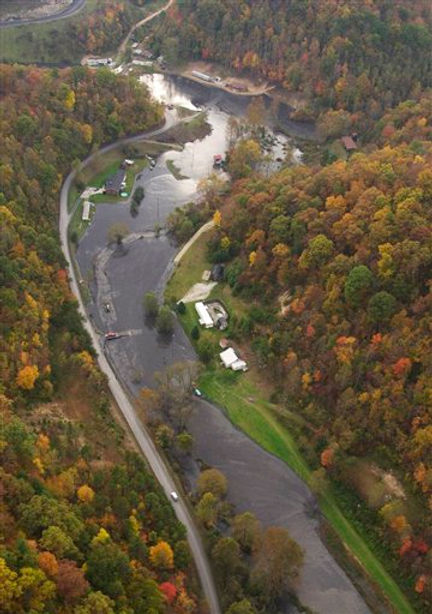"EVERYBODY KNOWS [THAT] IT'S NOT AN ACT OF GOD. IT'S A DISASTER..."
~ Martin County resident
COAL SLUDGE
Definition of Coal Sludge/Coal Slurry: A semi-liquid byproduct that forms when water separates combustible coal components from ash and toxic impurities (cadmium, arsenic, barium, etc.) during coal extraction and refinement.
Photo Citation: http://www.counterspill.org/disaster/martin-county-sludge-spill

THE MCCC COAL IMPOUNDMENT COAL SLUDGE RUPTURE
On October 11, 2000, at midnight, the MCCC coal slurry contained within the coal impoundment released approximately 300 million gallons of slurry into Wolf Creek, Coldwater Fork, the Big Sandy River, and Tug Fork River.
In 1994, there was a similar coal slurry rupture at the same mining impoundment. The MSHA mandated that the MCCC had to decrease the reservoir water levels and increase the dam walls. Similarly, the MCCC noted that there was an 100 foot coal barrier between the reservoir and the mines; in reality there was only 12 feet of dirt and coal. Therefore, the MCCC had ignored these recommendations and lied to the public about the impoundment conditions.
Specifically, many of the residents were not aware of the coal impoundment within the mountains so there was no emergency plan. Fortunately no one died.
The coal slurry contaminated the surrounding communities and the environment with "blackwater." It polluted approximately 90 miles of streams, 2,700 residential waterways, and killed roughly 1.6 million fish and other aquatic life.

CONTAMINATION CLEAN-UP
By approximately October 31, 2000, roughly 9.4 millon gallons of coal sludge were transferred into the impoundments after the rupture. The MCCC and the EPA treated the streams and soil with flocculation (calcium chloride and lime oxide) and sedimentation to siphon the impurities out of the environement.
Coldwater: To remove the sludge and reduce slurry contamination the MCCC and EPA used 3 dredges and 2 pipe lines to pump slurry to the impoundments. Four sedimentation ponds were constructed to reduce overflow from rain. The additional solidified sludge was removed with dump trucks and other machines.
WolfCreek: Two Gabion weirs were constructed to reduce contamination of more of the river and to monitor the flow of water into the tributaries of the river. Similarly, pipelines were constructed to pump slurry out of the streams and into the containment ponds, while other pipes transferred clean water in the creek.
MARTIN COUNTY WATER MARCH 20TH, 2018
Even today the effects of the coal sludge crisis are afflicting the community.
Photo Citation: https://www.cnn.com/2018/03/30/health/kentucky-water-crisis/index.html

COAL SLUDGE WITHIN MARTIN COUNTY AFTER THE RUPTURE
Photo Citation: http://aleet.pbworks.com/w/page/1705871/Pictures%20of%20Martin%20County%20Slurry%20Spill

COAL SLUDGE IN MARTIN COUNTY AFTER THE IMPOUNDMENT RUPTURE
Photo Citation: http://aleet.pbworks.com/w/page/1705871/Pictures%20of%20Martin%20County%20Slurry%20Spill

RESOURCES
ATSDR. Health Consultation MARTIN COUNTY COAL SLURRY RELEASE INEZ, MARTIN COUNTY, KENTUCKY EPA FACILITY ID: KYN000407233. 2006, http://www.atsdr.cdc.gov.
Epa, Us, et al. POLREP Number 7: Martin County Coal Corp Coal Slurry Release Multi-Regional Emergency Response Event. 2000, https://www.epa.gov/sites/production/files/2014-03/documents/polrep7.pdf.
Mcspirit, Stephanie, et al. Assessment of Finished Water, Public Water System: Martin County, KY. 2006, https://martincounty.eku.edu/sites/martincounty.eku.edu/files/Water_Fnl.pdf.
McSpirit, Stephanie, et al. “EPA Actions in Post Disaster Martin County, Kentucky: An Analysis of Bureaucratic Slippage and Agency Recreancy.” Journal of Appalachian Studies, vol. 11, no. 1/2, 2005, pp. 30–59. JSTOR, JSTOR, www.jstor.org/stable/41446653.
Portelli, Alessandro. They Say in Harlan County: an Oral History. Oxford University Press, 2012.
Salyer, Robert, director. Sludge. Appalshop Films, 2005.
Scott, Shaunna L., et al. “Post Disaster Interviews with Martin County Citizens: ‘Gray Clouds’ of Blame and Distrust.” Journal of Appalachian Studies, vol. 11, no. 1/2, 2005, pp. 7–29. JSTOR, JSTOR, www.jstor.org/stable/41446652.
Scott, Shaunna L., et al. “Risky Business: Coal Waste Emergency Planning in West Virginia and Kentucky.” Journal of Appalachian Studies, vol. 18, no. 1/2, 2012, pp. 149–175. JSTOR, JSTOR, www.jstor.org/stable/23337712.
